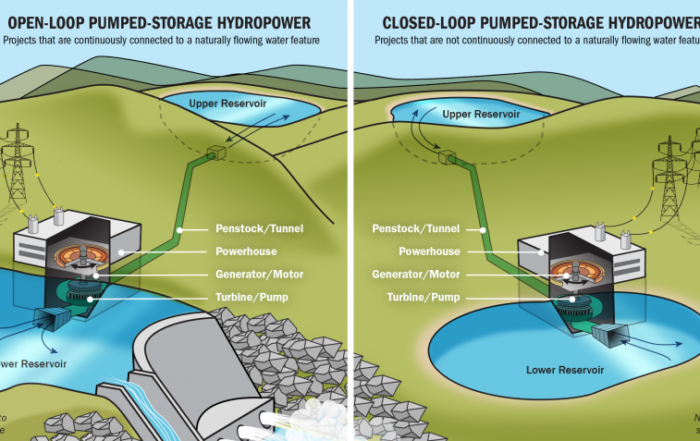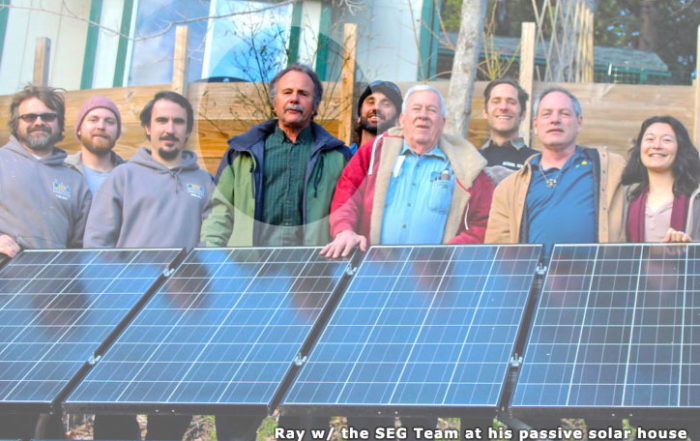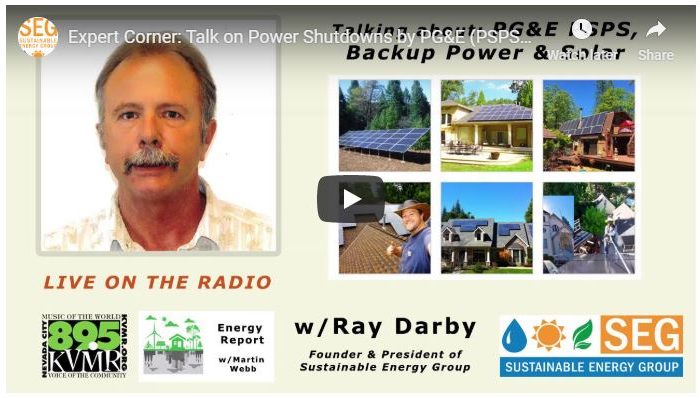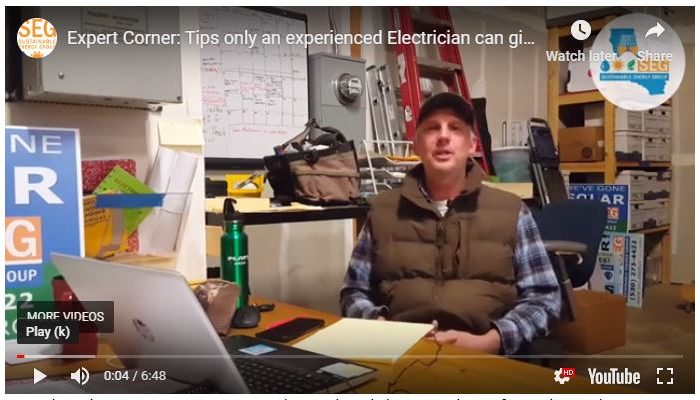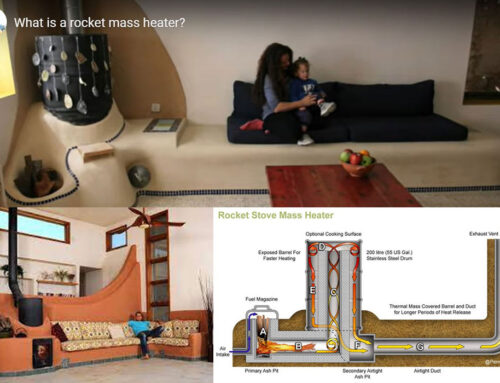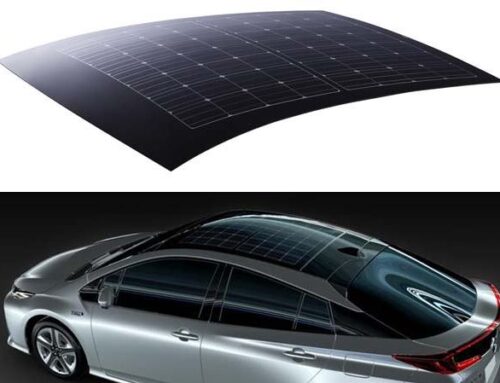POWER OUTAGES – Part 4
Adding Battery Storage To An Existing Solar System
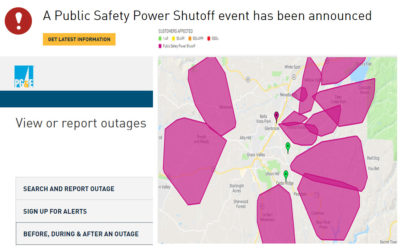

 As covered in Parts 1 through 3 of this series, there are all kinds of options to serve your backup power needs in the event of a power outage. To the uninitiated, adding battery storage to an existing solar system might seem straightforward – just buy some batteries and plug them in. However, to those of us with experience in this area it’s not at all straightforward in most cases. The answer depends on a whole host of questions over and above those covered in Parts 1-3 of this series, read them here ->
As covered in Parts 1 through 3 of this series, there are all kinds of options to serve your backup power needs in the event of a power outage. To the uninitiated, adding battery storage to an existing solar system might seem straightforward – just buy some batteries and plug them in. However, to those of us with experience in this area it’s not at all straightforward in most cases. The answer depends on a whole host of questions over and above those covered in Parts 1-3 of this series, read them here ->
First off your existing solar panels don’t need to be replaced. In most cases your solar grid-tie inverter (GTI), the equipment that converts the DC power from your panels into AC power doesn’t know how to deal with batteries.
There are two basic options – replace your inverter with one that knows how to play nice with batteries or add an extra battery-based inverter (BBI) that does.
By “play nice” we need to keep in mind your solar system will sometimes be capable of making more power than you or your batteries need. If that happens when you’ve lost utility power the solar panels need to turn off. Overcharging batteries can be an explosive experience so, to avoid that, the inverter needs to know to turn them off. If you haven’t lost utility power and your panels are making more power than you’re using, the excess is sent back to the utility for a credit.
The following will be as non-technical as possible while still giving some insight into the two main options, referred to as “DC Coupling” and “AC Coupling”. There are a whole host of compatibility and system design issues beyond the scope of this article that are best left to your solar company.
With DC Coupling, your existing Grid Tie Inverter (GTI) is replaced by a Battery Based Inverter (BBI.) These inverters are used in off-grid as well as grid-tied systems when battery backup is desired. The battery can be charged by your solar energy system, your utility or a generator depending on which is available.
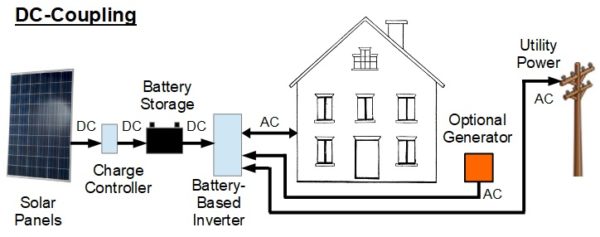


The DC power from your solar panels passes through a “charge controller” on its way to your battery. As the name implies, its role is to control the charging of your batteries. Proper battery charging is important for extending the life of the battery and it’ll stop charging the battery when it’s full as well, preventing them from being overcharged. From the charge controller, the DC power goes to the BBI where it’s converted into AC power for your use in your home or business whether the utility is available or not.
DC Coupling loses less of the energy produced by your panels because the conversion from DC to AC power only happens once.
It also makes sense for people with older “string inverters” that are close to the end of their useful life of 10 to 15 years. A battery-based inverter also allows for a wider range of battery sizes.
If you have a newer system that uses micro-inverters (like Enphase) or a power optimizer-based inverter (like SolarEdge), AC Coupling may make more sense. This is especially true if you have any significant shade moving over your panels, which was probably one of the reasons you went with one of these inverters in the first place.
With AC Coupling you can use your existing inverter and simply add a BBI, as they know how to handle a battery.
The DC power produced by your panels goes to your existing GTI and is converted to AC power as usual. From there, the inverter sends it to your BBI.
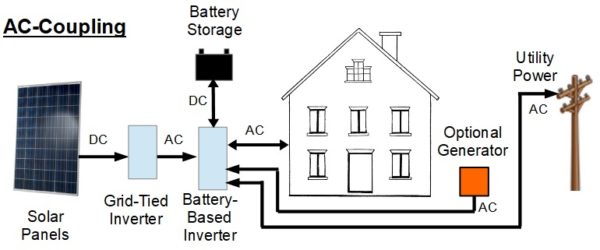


During a power outage the BBI stays safely disconnected from the utility to protect repairmen, just as a regular GTI is required to do. The battery inverter converts battery power to AC power for your use.
AC Coupling has some advantages and disadvantages. It can work with a variety of existing inverters and may be the easiest way to retrofit your existing system. In terms of disadvantages, it can be slightly less efficient because power from the GTI is AC, but batteries store DC power. For the battery to charge and discharge, the AC power from your GTI must be converted to DC for the battery, then back to AC for your use. This extra step causes more energy to be lost compared to DC Coupling.
There can be some limitations as to how much of your existing system you can use this way too if it’s bigger than the battery inverter and the battery. They typically cost more up front in equipment and labor too.
Retrofitting your existing system can be challenging, but an increasing array of options are coming out from several companies aiming to make the process simpler and more “plug and play”.
In addition to having battery backup for power outages, these systems can also help reduce the price you pay for power. With solar, the price you pay for the power you use, or the credit you earn for the excess power you make, depends on the time of day. When electricity demand is higher in the afternoon and early evening you pay a higher rate than what you do at other times. If you have a battery on your solar system you can use that power when the rates are high and save money. While that alone doesn’t typically justify adding batteries, it can be an added bonus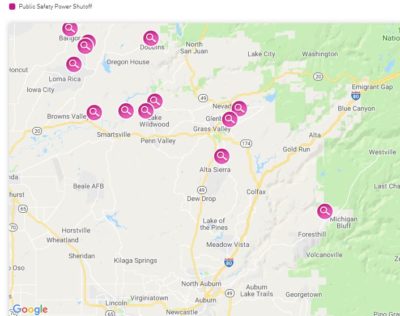


While batteries are quickly coming down in price, there are cheaper backup options for short term outages, but it depends on how much you need to back up and for how long. For long term outages generators may be undesirable due to fuel consumption and noise. In such cases a solar system with battery storage, possibly a generator option as well for occasional recharging if solar isn’t enough, can provide a complete solution.
This four-part series has been designed to help you understand your backup options in our Area of Nevada, Placer, El Dorado Counties as well as the surrounding area of Northern California.
I recommend you read the previous three articles on battery storage, generators, power outages with PG & E prior to making any decisions on how to proceed. In the meantime, please check out these links for important information about how to be prepared in the event of a utility outage in California and Nationwide:
Public Safety Power Shutoff tips – https://prepareforpowerdown.com/
The Safety Action Center contains helpful information about wildfire risks and what you can do before, during and after an emergency to keep your family safe.
https://www.safetyactioncenter.pge.com
SEG has a team of electricians who can install generators and automatic and manual transfer switches and have been doing so for over 15 years. Call us for a consultation on how to build this into your home or business. We hope this series of articles on backup power during PG&E power outages help you decide what works best for you in your situation. Give us a call today and find out how we can help with energy backups during power outages for Nevada County, Grass Valley, Nevada City, Penn Valley, North San Juan, Auburn and surrounding Placer and El Dorado Counties.


